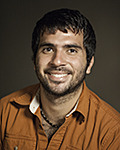
Daniel Garza
Las Vegas, N.M. — Highlands University graduate student Daniel Garza is the first researcher to produce a detailed geologic map of the Puy de Dome in central France, discovering that the iconic volcanic landmark likely developed in two phases rather than one as scientists thought.
At a height of 1,465 meters, Puy de Dome is the largest of 80 extinct volcanoes in the Chaine de Puys mountains range. Previous geologic research of the dome was limited to aerial surveys.
“My geologic mapping suggests that the first phase of the Puy de Dome involved a single magma pulse, with a second phase involving fault formation, along with further growth and deformation of the dome,” Garza said. “It was an incredible opportunity to conduct this new research on such a magnificent and historically significant volcano in the Chaine du Puys. I feel very privileged.”
His master’s thesis research in France this summer was thanks to an international exchange program developed by Highlands geology professor Michael Petronis and Benjamin Van Wyck de Vries, a geology professor at Blaise Pascale University in Clermont-Ferrant, France.
“Daniel’s research on Puy de Dome will likely add a transformative understanding to the growth of extinct lava domes worldwide,” said Petronis, Garza’s thesis adviser.
As part of his research, Garza also extracted rock samples of the Puy de Dome using a chain saw modified with a diamond-tipped drill bit.
“I was given access to drill on eight sites on the dome, which yielded a total of 418 specimens. My lab analysis at Highlands will help determine the underlying architecture of the Puy de Dome.
“I’ll use the rock magnetic instruments to analyze the flow direction of the magma. The paleomagnetic instruments will help determine the relative age of the rocks, and how the magma grew and moved,” Garza said.
Van Wyck de Vries supervised Garza for his summer fieldwork. Petronis taught Garza how to analyze rock samples using instruments in the cutting-edge Paleomagnetic–Rock Magnetic Laboratory at Highlands.
The 25-year-old first generation Mexican-American from Corpus Christi, Texas is the first in his family to attend college. After earning his bachelor’s in geology, he searched for graduate programs that offered research opportunities in environmental geophysics.
“Highlands is a small school that offers an impressive number of geology research opportunities, both locally and abroad. The geology professors are very knowledgeable in a broad range of topics. It’s easy to be scientifically curious when Dr. Petronis and Dr. Jennifer Lindline encourage students to take the initiative, and grow as researchers. I appreciate how they both have faith in me,” Garza said.
“From the time he arrived at Highlands, Daniel demonstrated that he is a highly intelligent, disciplined and motivated student in both field work and the laboratory,” Petronis said. “He’s also inquisitive and asks insightful questions. Daniel has all the hallmarks of an exceptional geophysicist.”
Outside the classroom, Garza is a leader. He serves in the graduate student senate and as the Highlands University Geology Society president. He also plays for the university’s Rugby club.
